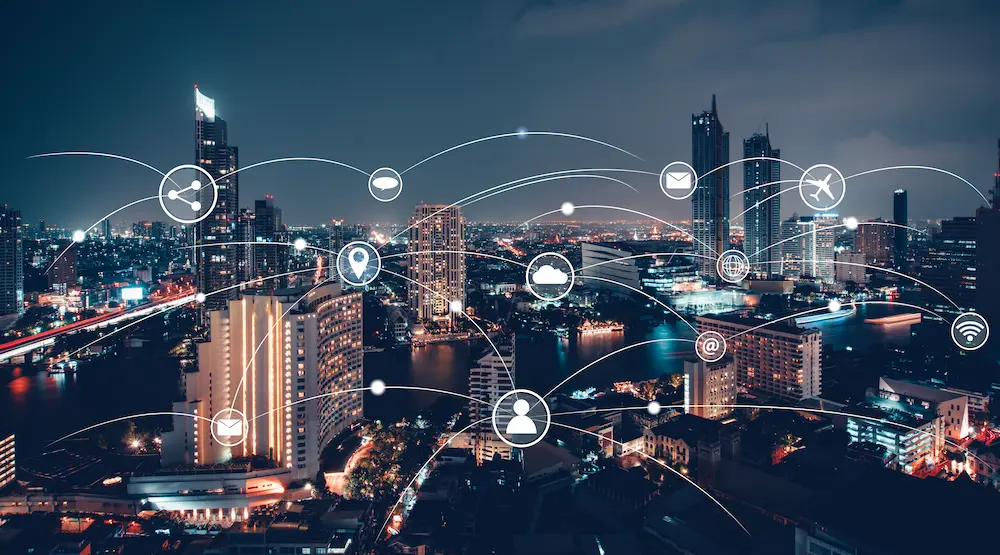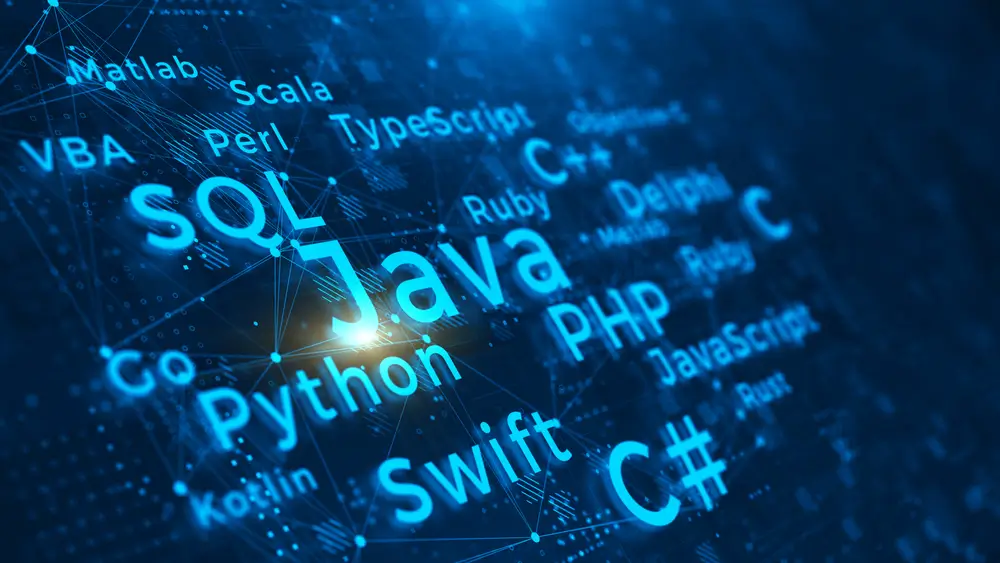When back in the 70s, technology visionaries said that the next step was making computers accessible for everyone, no one really believed them. Bill Gates had a mission: putting a computer on every desk. Steve Jobs dreamed of personal computers that were as intuitive as they were powerful. They foresaw a world where computers would be embedded everywhere, in everything.
Today, that vision is materializing, a new step to Mark Zuckerberg's Facebook vision of a connected social network: a computer inside everything, connecting everyone. Welcome to the Internet of Things: a vast network of interconnected devices transforming how we live, work, and interact with the world around us.
Understanding the Internet of Things is crucial in our modern world as the network of physical objects embedded with software is in vogue. The potential economic impact of IoT applications by 2025 is estimated to be between $3.9 trillion and $11.1 trillion USD.
The primary aim of IoT is to extend internet connectivity beyond standard devices like computers, smartphones, and tablets to a diverse range of devices and everyday objects, enabling them to communicate and interact with each other and the environment, thereby making them smarter and more responsive.
With this said, let’s dive into the IoT Market.
Understanding the IoT Market: Trends and Emerging Areas
IoT (Internet of Things) applications evolve driven by advancements in technology and the increasing need for automation, efficiency, and connectivity. First, let’s take a look at some of the key evolving trends in IoT applications. We can divide these trends into different categories regarding which aspect they attend:
Software and programming tendencies:
Edge Computing: Nowadays, it is becoming more and more popular to process data closer to where it is generated (on the edge) rather than relying solely on cloud computing.
This reduces latency, enhances real-time data processing, and lowers bandwidth usage.AI and Machine Learning Integration: Integrating AI and machine learning algorithms with IoT devices for smarter decision-making is also in vogue.
This enables predictive maintenance, advanced data analytics, and autonomous operations.5G Connectivity: Deployment of 5G networks provides faster and more reliable connectivity for IoT devices. This facilitates real-time data transfer, supports a higher number of connected devices, and enhances overall IoT performance.
Cybersecurity: Including security measures into IoT devices and networks can protect sensitive data, prevent cyber-attacks, and ensure user privacy.
Blockchain Integration: Combining IoT with blockchain technology for secure and transparent data transactions is also trending, as this enhances data integrity, improves supply chain transparency, and enables secure device communication.

Social and urban tendencies:
Smart Cities: Urban areas are implementing IoT technologies in urban areas to improve infrastructure, transportation, and public services. This optimizes energy use, enhances traffic management, and improves public safety.
Industrial IoT (IIoT): Another form of IoT is increasing its adoption in manufacturing and industrial sectors for automation and efficiency.
This streamlines production processes reduces downtime through predictive maintenance and improves supply chain management.Healthcare IoT (IoMT): Another trend regards to the growth of IoT applications in healthcare, also known as the Internet of Medical Things (IoMT). Incorporating IoT to healthcare enhances patient monitoring, improves diagnostics, and enables remote healthcare services.
Environmental Monitoring: The use of IoT sensors for monitoring environmental conditions such as air quality, water quality, and weather patterns is also trending as this supports environmental conservation, improves disaster response, and helps in climate change research.
Agriculture and Smart Farming: Implementing IoT in agriculture for precision farming and livestock monitoring is also trending as it increases crop yields, reduces resource consumption, and improves farm management.
Energy Management: IoT is also used for optimizing energy production, distribution, and consumption as it enhances grid management, supports renewable energy integration, and improves energy efficiency.
Personal comfort tendencies:
Smart Homes and Buildings: Another trend is the increase in the use of IoT devices in residential and commercial buildings for automation and energy management.
The benefit comes from comfort and convenience as well as the reduction of energy consumption and improved security.Wearable Technology: Small, portable devices are always the last trend in technology as they bring comfort. This is why there is significant growth in wearable IoT devices for fitness, health monitoring, and augmented reality.
This provides real-time health data, enhances personal safety, and offers new interactive experiences.
While trends show areas of significant growth, it is relevant to also pay attention to new and emerging areas for IoT implementation. In this section, we will only be attending to those that have not been mentioned or that allude to a specific aspect of the trends pointed out above. Some of the emerging areas for IoT implementation are:
Smart Retail: Utilizing IoT to enhance the retail experience for both customers and retailers is one of the main emerging areas for IoT implementation.
Connected Vehicles and Autonomous Transportation: Another emerging area addresses the integration of IoT with automotive technology to create smart and autonomous vehicles.
Urban Planning: Although we have mentioned the implementation of IoT for smart cities, its use for urban planning is also trending as it allows to carry out solutions to create more efficient and livable urban environments.
Healthcare Beyond Hospitals: Extending IoT applications in healthcare to home-based and remote care is also a relevant emerging area with remote patient monitoring, telemedicine, medication adherence systems, and smart medical devices.
Education and E-Learning: Another area where IoT is emerging rapidly is in education. IoT in educational environments enhances learning and administration with smart classrooms, attendance tracking, personalized learning experiences, and campus safety.

Explaining the Functionality of IoT Apps
The functionality of an IoT app revolves around its ability to connect, manage, and facilitate interaction with a network of IoT devices and the data they generate. At its core, an IoT app serves as a bridge between the user and their connected devices, providing a seamless interface for control, monitoring, and data analysis.
First, let’s take a look at how IoT works. When a user first engages with an IoT app, they can connect various devices to the network. This involves device onboarding, where the app guides the user through configuring network settings, such as Wi-Fi credentials, and ensuring that the device is properly connected and operational.
Once devices are connected, the app allows users to manage them, which includes tasks like firmware updates and remote control, ensuring that the devices remain up-to-date and function correctly.
Let’s delve into some of the key features and capabilities of IoT applications regarding what was mentioned above.
As IoT applications are platforms designed to manage and utilize connected devices, they offer a range of features and capabilities that enhance their functionality and user experience. These applications facilitate seamless device connectivity and management: users can easily set up and connect new devices to the network, enabling remote management and control. Here are some of the key aspects that help this connectivity:
First, data collection and visualization are fundamental aspects of IoT applications. These apps continuously collect data from connected devices, displaying it in real time through customizable dashboards. Users can view data in various formats, such as graphs, charts, and gauges, which help in monitoring device status and performance. Additionally, access to historical data allows for trend analysis and detailed reporting, providing deeper insights into device behavior over time.
Moreover, automation and scheduling capabilities are crucial for enhancing efficiency. IoT applications allow users to create automation rules based on specific conditions, such as turning on lights when motion is detected or adjusting thermostats based on temperature changes. Scheduling routines for device operations, like watering plants at designated times, further simplifies daily tasks and ensures consistent performance.
Notifications and alerts keep users informed of critical events, which is also a key feature. IoT applications send real-time alerts about important occurrences, such as security breaches or device malfunctions, allowing for prompt response. Users can customize notification preferences and choose their preferred communication channels, whether through push notifications, emails, or SMS.
Another relevant aspect is the integration with other systems. This enhances the functionality of IoT applications as they often provide APIs for seamless connectivity with third-party platforms and services.
(Dive into the latest emerging software development technologies that are reshaping the industry and discover how they're paving the way for the future of innovation.)
Compatibility with smart home ecosystems like Google Home, Alexa, and Apple HomeKit expands their usability, allowing users to control devices through these popular platforms. Additionally, integration with external services, such as weather data providers or energy management systems, adds further value.
Concerning this personal aspect, personalization and customization features enable users to tailor the application to their needs. Customizable dashboards allow users to display the most relevant information, while user-defined settings and profiles offer tailored experiences. Users can create different modes for various scenarios, such as home, away, or vacation, to optimize device behavior accordingly.
In addition, multi-user support ensures that IoT applications cater to different user needs. They provide role-based access, allowing different levels of control and management for various users. This feature is particularly useful in shared environments, where multiple users need to interact with the same set of devices. Specific permissions can be set for each user, ensuring appropriate access levels.
As for more formal aspects that still relate to user experience, scalability is another key capability of IoT applications. They are designed to support a large number of connected devices, efficiently managing network resources and bandwidth. Cloud integration plays a vital role in this, offering scalable data storage and processing capabilities to handle increasing amounts of data as the network grows.
In this sense, reliability and robustness are essential for maintaining consistent performance. IoT applications are built with fault tolerance, ensuring they remain functional even if some devices fail. Backup and recovery options are available for data protection, while high performance and low latency are maintained even with increased load.
Regarding more formal aspects, data analytics and insights also play a significant role in IoT applications. These apps help users anticipate future events or maintenance needs by analyzing collected data to provide predictive analytics.
Anomaly detection features identify irregularities in data that may indicate potential issues, allowing for proactive intervention. Performance metrics offer insights into device efficiency and usage patterns, enabling informed decision-making.
Another software-related aspect is security and privacy, which are both paramount in IoT applications. They ensure secure data transmission between devices and the app through encryption and robust authentication methods. User authentication and access control protect against unauthorized access, while stringent data privacy measures ensure that user information is handled securely.
Finally, the abovementioned tend to create a user-friendly interface that enhances the overall experience. IoT applications feature intuitive designs that are easy to navigate, with guided setup processes for configuring devices. Responsive design ensures compatibility across various devices and screen sizes, providing a seamless experience whether accessed via smartphone, tablet, or desktop.

Choosing the Right Tech Stack for Developing IoT Apps
Developing IoT solutions involves several core technologies that work together to enable devices to connect, communicate, and operate effectively. Here’s an overview of the main technologies used in IoT development:
Sensors and Actuators: While sensors collect data from the environment, such as temperature, humidity, motion, or light levels, actuators perform actions based on commands received from the IoT system.
Connectivity Technologies: Wi-Fi and Bluetooth or Bluetooth Low Energy (BLE) are some of the technologies most people are familiar with. Additionally, cellular networks such as 3G, 4G, and 5G provide broader coverage and higher data transfer rates, which is ideal for IoT devices that need to operate over large distances or in mobile contexts.
However, there are other technologies, such as Zigbee and Z-Wave, LoRaWAN, or NB-IoT (Narrowband IoT).
Cloud Computing: Cloud platforms provide scalable infrastructure for storing, processing, and analyzing IoT data. These offer scalable storage solutions to handle large volumes of data generated by IoT devices as well as advanced analytics tools in the cloud that enable processing and analyzing large datasets to extract valuable insights and support decision-making.
Edge Computing: This involves processing data closer to where it is generated rather than sending it to a central cloud server. Edge devices or gateways process data locally, perform initial analysis, and only send relevant data to the cloud.
Communication Protocols: MQTT (Message Queuing Telemetry Transport): A lightweight messaging protocol designed for low-bandwidth, high-latency networks. It is widely used in IoT for its efficiency in handling real-time data.
CoAP (Constrained Application Protocol): A web transfer protocol optimized for constrained devices and networks, commonly used in IoT applications for resource-constrained environments.
HTTP/HTTPS: Standard web protocols used for communication in IoT systems, especially for applications requiring more complex data exchange and security.
Data Security and Privacy: Encryption, Authentication and Authorization, and Secure Boot and Firmware Updates help protect data and privacy.
Artificial Intelligence and Machine Learning: AI and ML Algorithms are used to analyze data collected from IoT devices, predict trends, detect anomalies, and automate decision-making processes, while Edge AI integrates AI capabilities directly into edge devices, allowing for real-time data analysis and action without relying on cloud computing.
Application Development Frameworks: These provide tools and libraries for developing IoT applications, including device management, data collection, and analytics.
Development Tools and Languages: Commonly used languages for IoT development include Python, JavaScript, C, and C++, while Integrated Development Environments (IDEs) cover tools like Arduino IDE, PlatformIO, and others that facilitate writing, testing, and deploying IoT code.
Data Integration and APIs: APIs allow IoT applications to integrate with other services and systems, enabling data exchange and interoperability. Data Integration Tools, on the other hand, facilitate the aggregation and analysis of data from multiple sources, including IoT devices and external databases.
These technologies collectively enable the development of robust and scalable IoT solutions, facilitating the creation of smart environments, efficient systems, and innovative applications.
(Explore how AI is revolutionizing efficiency across industries and why embracing this technology could be the game-changer your organization needs.)
Let’s take a look at the following comparison charts to further understand all the nuances that come with IoT:
Programming languages

Frameworks

Platforms
Step-by-Step Guide to Developing an IoT App
Defining Comprehensive Requirements for the App
Selecting the Suitable IoT Platform
Acquiring Necessary Hardware Components
Determining the Ideal Network Protocol
Software Development and Integration
Testing and Quality Assurance Process
Deployment and Launch of the IoT Application
Cost Analysis: Estimating the Expenses of Creating an IoT App
Creating an IoT app involves a range of costs that can vary significantly based on the project's complexity, scale, and specific requirements. Understanding these expenses is crucial for accurate budgeting and planning. Below, we dissect some of the key aspects to consider when creating an IoT app.
Hardware Costs
Sensors and actuators gather and interact with the physical environment, and they can vary widely in price depending on their type and sophistication. For instance, simple temperature sensors may cost just a few dollars, while advanced sensors like LIDAR can be significantly more expensive.
Additionally, the cost of microcontrollers and development boards, such as Arduino or Raspberry Pi, is another important consideration. These components generally range from $10 to $100, depending on their features and capabilities. Connectivity modules for various communication technologies like Wi-Fi, Bluetooth, or cellular networks also contribute to the hardware costs, with prices ranging from $5 to $50 each.
Software Development Costs
Software development includes the cost of hiring a development team, which can vary based on location and expertise. Salaries for developers can range from $50,000 to $150,000 annually per developer. A project might require various specialists, including front-end and back-end developers, embedded system engineers, and UX/UI designers.
Platform and Cloud Costs
IoT platforms and cloud services play a critical role in managing and processing data. Costs for cloud platforms like AWS, Google Cloud, or Azure depend on factors such as data storage, data transfer, and computing resources.
Basic usage might cost a few dollars per month, but extensive use can drive expenses into the thousands. Similarly, IoT platforms often have tiered pricing models based on the number of devices, data volume, or features, which can range from free tiers to several thousand dollars per month for more comprehensive solutions.
Development Tools and Licenses
The costs of development tools and licenses can vary. While many integrated development environments (IDEs) and tools are free, some advanced tools or those with premium features might require a purchase. Licensing fees for specific software or libraries used in development can also add to the budget.
Testing and Quality Assurance
Ensuring that the IoT app functions correctly requires thorough testing and quality assurance. This involves purchasing additional devices for testing, which can range from a few hundred to several thousand dollars. Additionally, if a dedicated QA team is hired, their salaries typically range from $50,000 to $100,000 annually per QA engineer.
Deployment and Maintenance
Deploying the app to various platforms, such as app stores, incurs costs as well. Developer account fees for app stores typically range from $100 to $500 per year. Ongoing maintenance, including updates, bug fixes, and server maintenance, adds recurring costs. This can range from a few hundred to several thousand dollars per month, depending on the app's complexity and the required support.
Data Security and Compliance
Implementing robust security measures is essential to protect data and ensure compliance with regulations such as GDPR or HIPAA. The costs for encryption, secure data storage, and other security measures can range from a few hundred to several thousand dollars.
Marketing and User Acquisition
To successfully launch and promote the IoT app, a marketing budget is necessary. Costs for advertising and promotion can vary widely and might involve several thousand dollars initially. Additionally, providing user support, if required, adds another layer of expense, which could involve hiring support staff or using third-party services.
(Discover the four groundbreaking ways Jalasoft is pushing the boundaries of technology, setting new standards in the industry, and leading the charge into the future.)
Overcoming Challenges Faced in IoT Application Development

Common Challenges in IoT App Development
IoT app development presents several significant challenges.
One major issue is integrating diverse hardware components with software systems, which can be complex due to varying standards and communication protocols. This integration requires meticulous planning and testing to ensure compatibility and functionality.
Data security is another critical challenge, as IoT devices often handle sensitive information that must be protected against unauthorized access and cyber threats.
Ensuring robust security measures is vital to safeguarding data and maintaining user trust.
Scalability also poses difficulties, especially as the number of connected devices and the volume of data they generate grow. Managing these increasing demands can strain system resources and impact performance.
How to Address These Challenges
Let’s address these challenges one by one to understand IoT development without further complications and a simple approach,
For hardware and software integration, selecting compatible technologies and conducting thorough testing throughout the development process can help ensure seamless operation.
On the other hand, implementing strong security measures, including encryption, secure authentication, and regular updates, is essential to protect data and mitigate security risks.
To tackle scalability issues, leveraging scalable cloud services and adopting efficient data management strategies can help accommodate growing device networks and data volumes.
Additionally, investing in reliable connectivity solutions and robust infrastructure is crucial for maintaining performance and ensuring consistent operation across a large number of devices.
Innovative Approaches and Best Practices in IoT App Development
Most of the innovative approaches for enhancing user experience in IoT app development focus on intuitive design and seamless integration.
Advanced technologies like machine learning and artificial intelligence also enable the app to adapt to user preferences and provide personalized recommendations.
Additionally, improving real-time data processing and feedback mechanisms ensures that users receive timely and relevant information.
Another aspect is streamlining connectivity and integration with other smart devices, which also contributes to a more cohesive and responsive user experience, ultimately making the app more engaging and user-friendly.
Regarding Security and Privacy Protocols, it is important to understand how crucial this is for safeguarding user data and maintaining trust. This involves employing robust encryption methods to protect data both at rest and in transit, ensuring that unauthorized parties cannot access sensitive information.
Multi-factor authentication (MFA) adds an extra layer of security by requiring users to provide multiple forms of verification before accessing the app. In addition, regular security updates and patches are essential to address vulnerabilities and defend against emerging threats.
Last but not least, privacy measures, such as data anonymization and strict access controls, further protect user information and comply with data protection regulations.
Real-World Examples: Case Studies of Successful IoT Applications
In the smart home sector, apps like Google Home and Amazon Alexa have revolutionized home automation by enabling users to control lighting, climate, and security systems through voice commands and mobile interfaces.
In the healthcare industry, Fitbit and Apple Health have had a huge impact by providing users with detailed insights into their fitness and wellness. These apps track various health metrics, such as physical activity, heart rate, and sleep patterns, promoting healthier lifestyles and enabling better management of chronic conditions. They also facilitate remote monitoring of patients, improving access to healthcare and personalized treatment plans.
Industrial IoT applications, like GE Predix and Siemens MindSphere, have transformed manufacturing and industrial operations by offering advanced data analytics and predictive maintenance capabilities. These apps enable real-time monitoring of machinery, optimizing performance, reducing downtime, and enhancing operational efficiency. Analyzing data from connected sensors helps companies anticipate equipment failures and improve overall productivity.
Finally, in the transportation sector, apps such as Waze and Tesla’s Autopilot have made significant strides in improving navigation and vehicle automation. Waze uses crowd-sourced data to provide real-time traffic updates and route optimization, while Tesla’s Autopilot offers advanced driver-assistance features, contributing to safer and more efficient driving experiences.

Conclusion: Future Prospects and Trends in IoT App Development
The future of IoT is brimming with possibilities as ongoing advancements in technology drive the development of smarter, more responsive, and secure applications across a wide range of industries. From smart cities to healthcare, manufacturing, and beyond, IoT will continue to transform the way we live and work, making our environments more efficient and interconnected.
To fully capitalize on these emerging trends, having the right talent on your team is crucial. Jalasoft is here to help you navigate this rapidly evolving landscape by providing skilled developers who can enhance your team and bring your IoT vision to life. With Jalasoft’s expertise, you can stay ahead of the curve and lead the charge in this exciting new era of innovation.
